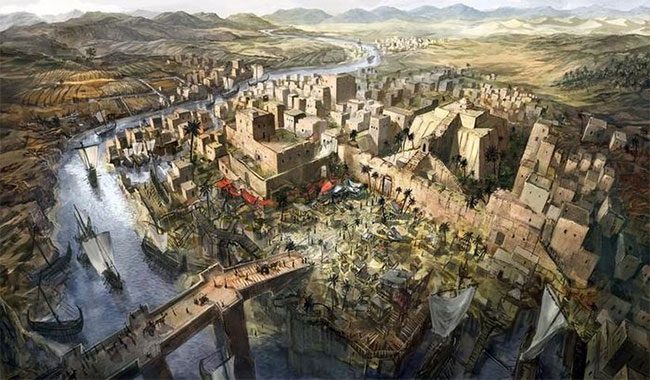Since its establishment in 2334 BC, the Akkadian Empire, the first empire of humanity, has continuously developed and flourished. However, about 180 years later, while at the peak of prosperity, it suddenly disintegrated.
The Superpower Empire

Prolonged drought wipes out the flourishing Akkadian Empire. (Image: Ancient-origins.net).
The Akkadian Empire was located in the region of Mesopotamia, Western Asia, one of the earliest cradles of civilization. Before the 24th century BC, Mesopotamia was a land divided into many small states.
In Southern Mesopotamia, there were four major city-states: Ur, Uruk, Lagash, and Kish, ruled by the Sumerians, while the North was governed by the Akkadians. Continuous wars broke out between the South and North, and even within the two regions, with territories constantly being seized from one another.
According to Mesopotamian legend, the one who unified the region was Sargon the Great (? – 2279 BC) of the Akkadians. His origins are unclear; it is said that he was a child abandoned by his parents, placed in a basket, and set adrift on a river. A farmer found this basket and raised Sargon the Great as his own.
Sargon the Great had a peaceful childhood. As he grew up, he was promoted to the position of cupbearer to the ruling class (a highly important and honorable job). Thanks to his contact with powerful individuals, he soon became an advisor and then rose to leadership. After unifying the Northern city-states, Sargon the Great conquered the Southern city-states, ultimately establishing the Akkadian Empire.
Mesopotamia was a land rich in resources and manpower, and it developed trade early on. The division and wars hindered trade development, causing the economy to stagnate. Under Sargon the Great’s unification, all trade routes were opened. Naturally, goods flowed safely, and commerce flourished.
After Sargon the Great, his descendants made efforts to protect the integrity of the empire and continued to develop trade, expanding commerce with other nations. Although the Southern city-states of Mesopotamia frequently revolted, they were always suppressed. King Manishtushu (2269 – 2255 BC) even won battles against a coalition of 32 city-states, gaining control over the pre-Arab territories (now the United Arab Emirates and Oman).
In the 23rd century BC, the Akkadian Empire reached its peak of prosperity. Thanks to fertile land and the appropriation of food and wealth from wars, the Akkadian Empire became exceedingly wealthy.
King Naram-Sin, who ruled from 2254 – 2218 BC, recklessly expanded the borders to the West and South. The Akkadian territory included the entire region of Mesopotamia, the Near East, and Anatolia, extending all the way to the Arabian Peninsula.

Sargon the Great, founder of the Akkadian Empire. (Image: Ancient-origins.net)
Victim of Climate Change
With numerous military achievements, King Naram-Sin arrogantly proclaimed himself a “living god.” Just 68 years after his reign, the once-mighty Akkadian Empire suddenly collapsed completely. Mesopotamian legends say this was a divine punishment.
The first to suffer this punishment was King Shar-Kali-Sharri, son of King Naram-Sin, who ruled the Akkadian Empire from 2217 – 2193 BC. During Shar-Kali-Sharri’s reign, the Southern city-states of Mesopotamia revolted in succession, demanding secession and independence.
The king struggled to suppress them, maintaining the empire’s integrity. However, his successors focused only on throne disputes, ultimately creating opportunities for the city-states to successfully rebel, leading to the complete disintegration of the Akkadian Empire in 2150 BC.
From a modern perspective, divine punishment seems irrational. For many years, scholars have attempted to decode the sudden and complete collapse of the Akkadian Empire. In 1993, they found substantial evidence suggesting that this ancient superpower could have vanished due to a climate disaster, specifically a prolonged drought lasting 300 years, beginning around 2200 BC.
In-depth analysis of soil samples collected from Akkadian settlement sites in Northern Mesopotamia revealed that this region had experienced unprecedented heat waves, transforming fertile plains into deserts that could not be cultivated due to severe water shortages.
As the drought continued, the city-states fell into famine. The populace was forced to migrate South to areas with more rainfall, leaving their cities behind.
Despite the evidence of drought, researchers cannot explain the cause of it. Some speculate it was due to changes in wind patterns and ocean currents, while others attribute it to volcanic eruptions.
Moreover, there is a hypothesis suggesting that the collapse of the Akkadian Empire was due to the poor governance of the administrative system. Continuous crop failures and rampant famine led to increasing chaos among city-states. At this moment, the Akkadian Empire was also struck by a massive meteorite, leading to its complete obliteration.
Recently, a research team led by Dr. Stacy Carolin collected some stalagmites from a cave in Iran and discovered they contained higher magnesium levels than local limestone.
Considering the location, this cave is situated to the East of the Akkadian Empire, quite far from its borders and in the direction of the winds blowing from the Akkadian Empire. The stalagmites collected by Dr. Carolin’s team were likely formed from dust from the Syrian and Iraqi deserts (within the Akkadian Empire) carried by the wind. The high magnesium concentration in them indicates that the last 50 years of the Akkadian Empire were indeed severely affected by drought.
After the disintegration of the Akkadian Empire, Mesopotamia was dominated by the Gutians (Near East). Around 2100 BC, power shifted to the Sumerians. Throughout the 184 years of the Akkadian Empire, the Akkadian language became the lingua franca. Thus, even when the Sumerians held power, the language of the Mesopotamian region remained Akkadian. Later, even the Assyrians and Babylonians used this language, with only minor adaptations.


















































